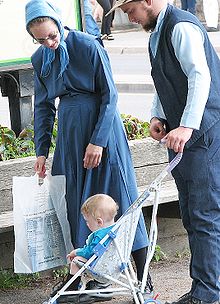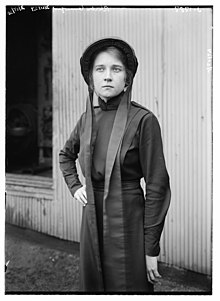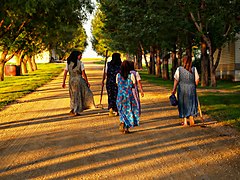
A veil is an article of clothing or hanging cloth that is intended to cover some part of the head or face, or an object of some significance. Veiling has a long history in European, Asian, and African societies. The practice has been prominent in different forms in Judaism, Christianity, and Islam. The practice of veiling is especially associated with women and sacred objects, though in some cultures, it is men, rather than women, who are expected to wear a veil. Besides its enduring religious significance, veiling continues to play a role in some modern secular contexts, such as wedding customs.
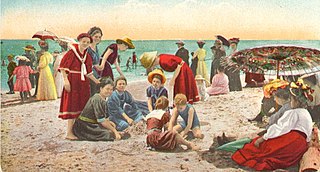
Modesty, sometimes known as demureness, is a mode of dress and deportment which intends to avoid the encouraging of sexual attraction in others. The word modesty comes from the Latin word modestus which means 'keeping within measure'.
The Holiness movement is a Christian movement that emerged chiefly within 19th-century Methodism, and to a lesser extent influenced other traditions such as Quakerism, Anabaptism, and Restorationism. The movement is historically distinguished by its emphasis on the doctrine of a second work of grace, generally called entire sanctification or Christian perfection and by the belief that the Christian life should be free of sin. For the Holiness movement, "the term 'perfection' signifies completeness of Christian character; its freedom from all sin, and possession of all the graces of the Spirit, complete in kind." A number of evangelical Christian denominations, parachurch organizations, and movements emphasize those beliefs as central doctrine.

Plain people are Christian groups in the United States, characterized by separation from the world and by simple living, including plain dressing in modest clothing. Many Plain people have an Anabaptist background. These denominations are largely of German, Swiss German and Dutch ancestry, though people of diverse backgrounds have been incorporated into them. Conservative Friends are traditional Quakers who are also considered plain people; they come from a variety of different ethnic backgrounds.
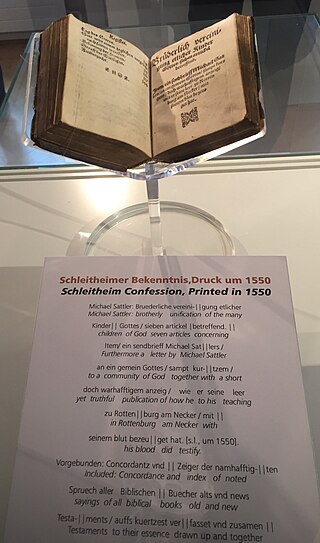
Anabaptist theology, also known as Anabaptist doctrine, is a theological tradition reflecting the doctrine of the Anabaptist Churches. The major branches of Anabaptist Christianity agree on core doctrines but have nuances in practice. While the adherence to doctrine is important in Anabaptist Christianity, living righteously is stressed to a greater degree.

Bonnet has been used as the name for a wide variety of headgear for both sexes—more often female—from the Middle Ages to the present. As with "hat" and "cap", it is impossible to generalize as to the styles for which the word has been used, but there is for both sexes a tendency to use the word for styles in soft material and lacking a brim, or at least one all the way round, rather than just at the front. Yet the term has also been used, for example, for steel helmets. This was from Scotland, where the term has long been especially popular.

A headscarf is a scarf covering most or all of the top of a person's, usually women's, hair and head, leaving the face uncovered. A headscarf is formed of a triangular cloth or a square cloth folded into a triangle, with which the head is covered.

A prairie dress or prairie skirt is a modest American style of skirt, an article of women's and girls' clothing.
The conservative holiness movement is a loosely defined group of theologically conservative Christian denominations with the majority being Methodists whose teachings are rooted in the theology of John Wesley, and a minority being Quakers (Friends) that emphasize the doctrine of George Fox, as well as River Brethren who emerged out of the Radical Pietist revival, and Holiness Restorationists in the tradition of Daniel Sidney Warner. Schisms began to occur in the 19th century and this movement became distinct from parent Holiness bodies in the mid-20th century amid disagreements over modesty in dress, entertainment, and other "old holiness standards" reflective of the related emphases on the Wesleyan–Arminian doctrine of outward holiness or the Quaker teaching on the testimony of simplicity or the River Brethren and Restorationist teachings on nonconformity to the world, depending on the denomination. Christian denominations aligned with the conservative holiness movement share a belief in Christian perfection, though they differ on various doctrines, such as the celebration of the sacraments and observance of ordinances, which is related to the denominational tradition—Methodist, Quaker, Anabaptist or Restorationist. Many denominations identifying with the conservative holiness movement, though not all, are represented in the Interchurch Holiness Convention; while some denominations have full communion with one another, other bodies choose to be isolationist.
Outward holiness, or external holiness, is a Wesleyan–Arminian doctrine emphasizing modest dress and sober speech. It is a testimony of a Christian believer's regeneration, done in obedience to God. The doctrine is prevalent among denominations emerging during the revival movements, including the Methodists, as well as Pentecostals. It is taken from 1 Peter 1:15: "He which hath called you is Holy, so be ye holy in all manner of conversation."

Christian head covering, also known as Christian veiling, is the traditional practice of women covering their head in a variety of Christian denominations. Some Christian women wear the head covering in public worship and during private prayer at home, while others believe women should wear head coverings at all times. Among Oriental and Eastern Orthodox Churches, certain theologians likewise teach that it is "expected of all women to be covered not only during liturgical periods of prayer, but at all times, for this was their honor and sign of authority given by our Lord", while others have held that headcovering should at least be done during prayer and worship. Genesis 24:65 records the veil as a feminine emblem of modesty. Manuals of early Christianity, including the Didascalia Apostolorum and Pædagogus, instructed that a headcovering must be worn by women during prayer and worship as well as when outside the home. When Saint Paul commanded women to be veiled in 1 Corinthians, the surrounding pagan Greek women did not wear headcoverings; as such, the practice of Christian headcovering was countercultural in the Apostolic Era, being a biblical ordinance rather than a cultural tradition. The style of headcovering varies by region, though Apostolic Tradition specifies an "opaque cloth, not with a veil of thin linen".
Many Christians have followed certain dress codes during attendance at church. Customs have varied over time and among different Christian denominations. As with the Bible, the Church Fathers of Christianity taught modesty as a core principle guiding the clothing that Christians are to manufacture and wear.
Religious clothing is clothing which is worn in accordance with religious practice, tradition or significance to a faith group. It includes clerical clothing such as cassocks, and religious habit, robes, and other vestments. Accessories include hats, wedding rings, crucifixes, etc.
Pentecostalism is a renewal movement within Protestant Christianity that places special emphasis on a direct personal relationship with God and experience of God through the baptism with the Holy Spirit. For Christians, this event commemorates the descent of the Holy Spirit upon the followers of Jesus Christ, as described in the second chapter of the Book of Acts. Pentecostalism was established in Kerala, India at the start of the 20th century.

A cape dress describes a woman's dress which combines features of the cape and the dress. Either a cape-like garment is attached to the dress, pinned or sewn on, and integrated into its construction, or the dress and cape are made to co-ordinate in fabric and/or colour.
Charity Ministries, also called Charity Christian Fellowship, is a Conservative Anabaptist network of churches that was formed in 1982 in Lancaster County, Pennsylvania.
A swimming dress, also known as a swim dress, is a modern dress worn by women while swimming that preserves traditional religious definitions of modesty. Swimming dresses are popular among Christians belonging to the conservative holiness movement, Orthodox Jews and many Muslims; many wearers of swimming dresses, such as the Methodists of the conservative holiness movement, believe that modern popular practice of the wearing of trousers by women blurs the distinction between men and women, while others, such as adherent Muslims teach that pants should not be worn by women as they reveal the contour of the legs that should be hidden to maintain modesty. Swimming dresses have sleeves that usually go beyond the elbows as well as hemlines that extend beyond the knees for the purpose of maintaining traditional religious definitions of modesty. In Israel, they are known as Shvimkleid. In recent years, the demand for modest clothing has risen, which may be due to the growth of religious traditions such as Apostolic Pentecostalism. This has led to a greater interest in swimming dresses.

A kapp is a Christian headcovering worn by many women of certain Anabaptist Christian denominations, as well as certain Conservative Friends and Plain Catholics, in obedience to Paul the Apostle's command in 1 Corinthians 11:2–10.

A hanging veil, also known as a flowing veil or charity veil, is a type of Christian headcovering, which is worn by some Christian women continually, in obedience to Paul the Apostle's command in 1 Corinthians 11:2–10. Hanging veils enjoy popularity in a diverse array of Christian denominations, especially those of the Anabaptist Christian tradition. In certain Conservative Mennonite Anabaptist congregationations of the Beachy Amish Mennonite tradition, an opaque hanging veil is permitted as an alternative to the kapp if it covers as much or more hair as the kapp, which traditionally is "of ample size to cover most of the hair". Opaque hanging veils are usually white or black in colour for modesty. Hanging veils are designed to drape over the natural curves of a woman's head and hang down a woman's neck. Certain denominations of Christianity provide guidelines regarding the headcovering; the Ministry Training Center of the Biblical Mennonite Alliance, for example, teaches:
A veiling shall be worn by the sisters. We believe the best application of the headship principle as taught in I Corinthians 11 is for the veiling to be worn as a part of their regular attire to cover hair that is allowed to grow to its natural length. Ladies shall wear all their hair neatly up, avoiding fashion extremes, covered with a hanging veil, scarf, or traditional Mennonite covering of sufficient size to substantially cover the hair. Hanging veils and scarves must cover at least from the crown of the head to the bottom of the hair bun.
Conservative Anabaptism includes theologically conservative Anabaptist denominations, both in doctrine and practice. Conservative Anabaptists, along with Old Order Anabaptists and assimilated mainline Anabaptists, are a subset of the Anabaptist branch of Christianity.
